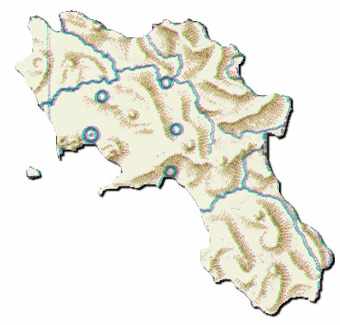
|
CAMPANIA
|
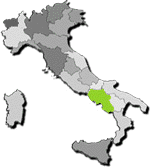
Back to Italy |
Provinces -
This region has 5 provinces: Avellino, Benevento, Caserta, Napoli, Salerno
Chief town - Napoli
Surface - kmq 13596
National Park - National Park of Cilento and Vallo of Diano (1991)
National Park of Vesuvio (1991)

Russian Version |
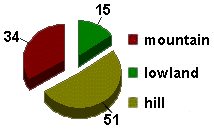 |
|
Origin of the name:
The zone around Capua up to the time of the Romans was
called Agro Capuano, subsequently it became Agro Campano and in the end Campania. This was
the name given to coastal tirrenica and to the zone of the band. After the unity of the
country was passed and there were numerous divisions of the zone, between the Dukedom in
Naples, the Dukedom of Benevento, the Principality of Salerno and the Dukedom in Amalfi.
With the constitution of the Kingdom of Italy in 1861, the Region brought its name of
Campania, but clearly with more wide confinements.
| Reliefs - Passes - Coasts -Islands |
| The territory of Campania is
constituted by the Appennino Campano that goes down toward the coast tirrenica with
alternating mountainous chains and mountainous groups positioned in an irregular way. The
group of Sella of Conza, divides the Appennino Campano from that Lucano. To north are the
Mountains of Matese to which belong the tallest top of the Region of 2050
meters. It continues with the Mountains of Sanni, the Mountains of Irpinia and the group
of the Picentinis Mountains. The Peninsula Sorrentina is formed by the Lattaris Mountains.
The rich zone of the Cilento between the Gulf of Salerno and the Gulf of Policastro, owes
its vitality to a flourishing agricultural production as well as pastures. The coasts are
jagged and they form four gulves: the Gulf of Gaeta, the Gulf in Naples, the Gulf of
Salerno and the Gulf of Policastro. To north we find the Gulf of Gaeta of which half of
its territory is the region of Lazio. |

Sees of the port of Naples with the Vesuvius
in the background
|
The coast presents itself regulated and level. In a only a
line is it interrupted by the mouth of Delta Volturno. Going down more to south we
find between Capo Miseno and the Point Campanella, the Gulf of Naples. The coast
introduced itself with tall rocky bluffs in the extremities of the Gulf, up to where it
goes down with ample level expanses in the central part. Situated between Peninsula
Sorrentina and Point Licosa is the Gulf of Salerno that introduces itself with tall rocky
coasts in the extremities up to its border toward the center of the Plain, one of
the Sele level zone which is almost entirely in the swampy zones . In the southern part,
to south of the Point Licosa it goes down in the sea, with a very jagged coast, tall and
rocky, the highland of the Cilento. Capo Palinuro is the only place with the sandy coasts.
In the coasts going down toward south there are tall coastal slants up to 500 ms from the
sea, rich caves and spectacular inlets. In the extreme south of Campania is the Gulf of
Policastro, really a border with Basilicata. The Gulf in Naples contains the Islands
Partenopee, Ischia, Capri and Procida.
| Landscape: |
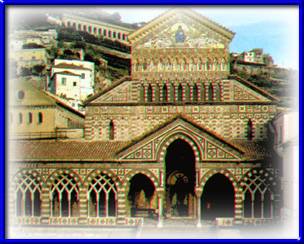
The Cathedral of Amalfi
|
Campania is one of the most
luxuriant regions of vegetation, with perpetualy mild climate and very beautiful
territories. The sea is a very important element in the panoramas of the territory. In the
coast numerous inlets are found, gulves, steep bluffs, peninsulas and of calm bays. The
islands are situated in front of the coast and they are composed of rocks and
particular colors of nature. A particularity of the Region is the presence of volcanos.
One of them is the Vesuvius, that even if inactive, has not extinguished and dominates the
whole Gulf in Naples. The fertility of the underlying lowland is due to the volcanos. The
other aspects of Campania are due to the mountainous zone composed by arid and bare tops,
where the cultivation and the communication is scarce and often suround inhabitants in the
winter snowfalls. |
The Region very rarely shows its extraordinary strength
that it holds confined within itself such as earthquakes; and volcanic eruptions. Even if
held under control they are always a constant danger.
Agriculture - Stock - Farm -
Fishing:
A big part of the territory of Campania is mountainous
and water is scarce, therefore the only agricultural zones exploited for cultivation
are those near to shelter and the coastal zones such as Naples Caserta and Salerno which
are favored by the very fertile volcanic grounds, and from the abundance of water and also
from the optimal climate, which enable it to be largely productive. Campania to the
vertexes is set for the quality and the productivity of the agricultural products. It
holds the supremacies in the production, distributed nationaly, of tomatos, potatoes,
eggplants, peppers and peas, besides the fruit of fig trees, apricots, plums and cherries.
To facilitate the production of these most profitable products, the grounds used for the
production of cereals have been reduced. Very important is also the production of citrus
fruit, wine, oil; over that hemp and tobacco. From Campania the hemp of the Italian market
is distributed to almost all. The breeding is constituted in good part from cattle and
buffalos, characteristic of the region. In the climb zones there is the breeding of ovini,
especially goats. The sea doesn't offer a rich fishing and accordingly it is little
practiced. The only exploited zones are those adjacent to the coasts where they fish
molluscs and shellfishes, the primary components of the kitchen of Campania.
| Industry - Tourism: |
| The industry is developed
especially in the zones in Naples and Salerno. Together with Puglia it holds the supremacy
of the industrial wealths. Diffused are the establishments that work agricultural
products. The most important products are cheese, preserves of tomato, salamis and jams.
The alimentary industries that excel are the pastificis that produce many qualities of
pasta. Between the principal mechanics fittings and those more heavy, we find
factories from the Olivetti to Pozzuoli wich produce calculators and typewriters, the
alpha South to Pomigliano d'Arco with the auto fittings, the iron industries of Bagnoli,
the shipyards of Castellamare of Stabia, over that chemical establishments, pharmaceutical
and oil refineries. The biggest cotonificis are found in province of Salerno. |
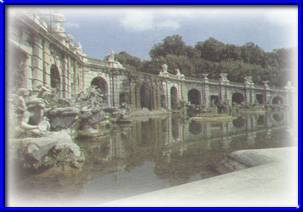
Fountain of Eolo in Caserta
|
Craftsmanship plays a very important role in the local
activities; Naples is known as the area where there is the greatest distribution of little
objects such as embroiders, inlays and camei and Capodimonte as well as the famous
porcelains. Typical is the workmanship of the cameis who work on volcanic stone and on the
madreperla, as well as corals and the turtle from the zone of the Greek Towers. The
tourism represents an important voice in the economy of Campania. The mild climate, the
charm of the landscapes of Capri and Ischia and the artistic beauties of the
archaeological zones in Pompei and Paestum, attract a lot of tourists from around
the world.
Position and Frontier:
The territory of Campania is situated between the
Appennino Campano and the Tyrrhenian Sea. To the north Campania confines the Lazio and
Molise, to the east Puglia and Basilicata and both to the south that is to the east
with the Tyrrhenian Sea.
Rivers - Lakes:
The principal rivers of Campania are Volturno,
Garigliano on the border with Lazio, Calore tributary of the Volturno and the Sele. All
these rivers have an outlet in the Tyrrhenian Sea. Other courses of water such as the
river Ofanto flow in the Adriatic Sea. The territory consists of small lakes next to the
coast such as the Lake of Averno that is of volcanic origin, the coastal Fusaro and the
Lake of Matese that it is instead of carsica origin .
Climate:
The climate in the coastal band, in the lowlands and in the
islands is incredibly mild. In the mountain zones despite the abundant winter snowfalls,
the climate is rather sweet.
Population:
Despite the reduced dimensions of the territory,
Campania is the second after the Lombardy for the number of inhabitants. The distribution
of the population is very diseguale. Along the coast we find some big comglomerations,
that almost melt with others that are close, while in the high zones such as the towns of
Metese and of Cilento, we find a scarce presence of inhabitants. Only in the
territory and province of Naples do we find over half the general population. In the
agricultural zones the residences are centralized in the country. Emigration has raised;
since the beginning of the century many inhabitants of this region emigrated toward the
United States while today they are moving to the varied Italian or European regions.
Communication:
The city of Naples is the principal center for
communications either traffic or by railway. With two ultramodern railway lines that
connect it to Rome and then branch out toward the north, while others are less developed
they connect it with Bari and Reggio Calabria. A lot of secondary lines connect the
smallest and most external centers. The biggest highway is that of the Sun that originates
from Rome, then continues to Naples, Salerno and finally to arrives up to Reggio Calabria.
Another highway crosses the Appennino and colleague Puglia. In the most part of the the
roads follow the old Roman streets such as the Street Dominziana and the Street Appia.
Web Site designed by MediaSoft - © Copyright 1998-1999
- All rights reserved




